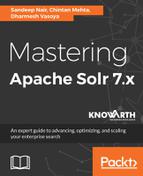Apache Solr is one tool that has some common features such as full-text search, facets-based search, clustering on demand, the ability to select highlighters, indexing on demand, database integration, geospatial searches, NoSQL features, fault tolerance, scaling on demand, and the ability to handle all sorts of documents (such as PDF, docx, ppt, and more). Solr finds its intense use in enterprise searches and huge analytics. Due to such powerful features, major players in the world such as Instagram, Netflix, NASA, and eBay are using Solr.
Solr runs as a standalone server with the option of having clusters as per demand. Internally, it makes use of the Lucene Java search library and has full support of REST like HTTP/XML and JSON APIs. This makes it possible to use most of the available programming languages even without Java coding. You feed Solr data over HTTP and Solr responds with an output in formats of JSON, CSV, and binary. Apache Lucene and Apache Solr were merged in 2010 and they are collectively termed Lucene/Solr or Solr/Lucene. This chapter focuses mainly on the following points:
- Solr installation
- Understanding various files and the folder structure
- Running and configuring Solr
- Loading sample data
- Understanding the browser interface
- Using the Solr admin interface
